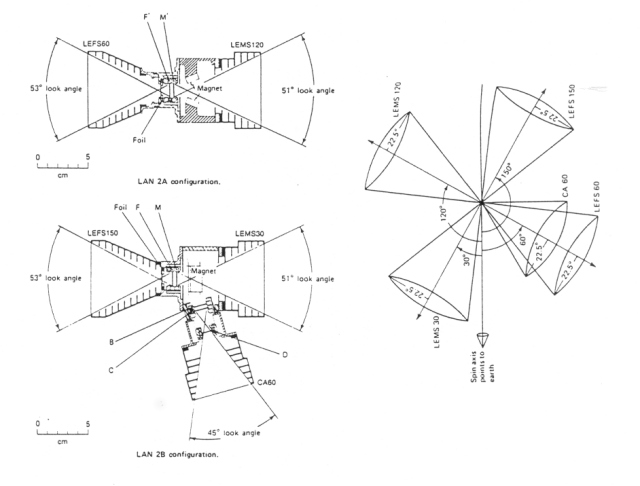Ulysses HISCALE Data Analysis Handbook
Appendix 10. Effect of Backscattered Electrons on the Geometric Factors of the LEMS30 Telescope (Hong MS Thesis)
A10.1 Chapter 1 - HISCALE Instrumentation
The Ulysses spacecraft (see Figure A10-1 below), launched on 6 October 1990, is the first to make measurements in the heliosphere far from the ecliptic plane and over the polar regions of the Sun. The HISCALE (Heliosphere Instrument for Spectral, Composition and Anisotropy at Low Energies) instrumentation carried by the spacecraft includes five separate solid-state detector telescopes, which are designed to measure the flux of interplanetary charged particles (ions and electrons). The ions and electrons are identified uniquely by the detectors in the range of energy (Ei >= 50 keV and Ee >= 30 keV) and are separated into several energy passbands and arrival directions. The observational results will help scientists understand physical processes involved in the solar control of low energy particles and other low energy interplanetary particle phenomena in the heliosphere.
Figure A10-1 The Ulysses Spacecraft

The HISCALE instrument is mounted on one corner of the Ulysses spacecraft (see Figure A10-1). The five detector telescopes are LEFS 60, LEFS 150, LEMS 30, LEMS 120 and CA 60 (see Figure A10-2), where LEFS/LEMS stands for Low Energy Foil/Magnetic Spectrometers, and CA refers to the Composition Aperture. Electrons with less than 300 keV energies in LEMS are deflected away from the detector M (see Figure A10-2) and counted by a separate detector B. Ions in LEMS are not deflected and enter the M detector. The LEFS telescope has a thin aluminized parylene foil preventing lower energy ions (Ei <= 350 keV) from reaching the F detector, while electrons (Ee >= 35 keV) can penetrate the foil with little energy loss. The CA is used to identify light and heavy ions using a two-parameter (dE/dx and E) measurement.
Figure A10-2 The outline of HISCALE telescopes

The objective of this study is to refine the calculation of geometric factors of the deflected electrons in the LEMS 30 telescope by including the effect of backscattering electrons. The incoming electrons enter LEMS 30 and are deflected in the inhomogeneous magnetic field produced by a pair of tilted rare-earth magnets according to the Lorentz law:

Only low energy electrons can be deflected and enter detector B. The magnets are not able to deflect high energy electrons or massive ions to detector B. Thus the main purpose of detector B is to measure low energy electrons. However, not all electrons entering the telescope chamber are counted by the detector, since some of them collide with the surface of the telescope chamber. Some of those electrons are absorbed by the target material, some of them are transmitted, and the remaining electrons are backscattered. Buckley has done the geometric factor calculation without considering the effect of backscattering electrons from the surface of the LEMS 30. The main objective of this study is to extend the geometric factor calculation based on what has been done by John Buckley by including the elastic single backscattering electron effect on the LEMS 30 telescope. The rest of this thesis includes: in section A10.2, the geometric factor and backscattering implementations; in section A10.3, the numerical procedures; and in section A10.4, the discussion of the results.
Next: A10.2 Chapter 2 - Geometric Factor
Return to the Table of Contents for Hong's MS Thesis
Return to HISCALE List of Appendices
Return to Ulysses HISCALE Data Analysis Handbook Table of Contents
Updated 8/8/19, Cameron Crane
QUICK FACTS
Mission End Date: June 30, 2009
Destination: The inner heliosphere of the sun away from the ecliptic plane
Orbit: Elliptical orbit transversing the polar regions of the sun outside of the ecliptic plane



